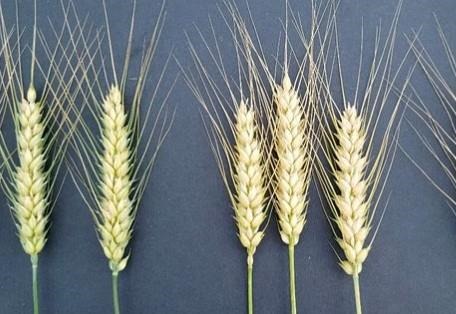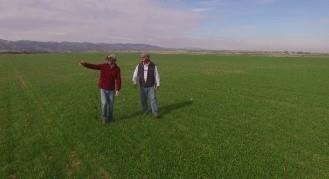By Emmanuel Byamukama
A few winter wheat fields in central South Dakota have been found with wheat streak mosaic disease (Figure 1). Incidence of this disease varied from a few plants to large portions of the field with yellowing leaves.
This disease can be confused with frost injury, herbicide injury or nitrogen deficiency. Frost injury is quite widespread in South Dakota due to subfreezing night temperatures in the past few days.

Figure 1. A portion of a winter wheat field with plants yellowing due to wheat streak mosaic virus infection.
Symptoms
Symptoms observed in wheat at this time are a result from infections that occurred during the fall. Symptoms start as small chlorotic lines, which expand to form pale, green-and-yellow stripes. The green-and-yellow patterns form the typical mosaic symptom.
Symptoms are more obvious on older leaves, which have severe yellowing symptoms (Figure 2). Depending on the time of infection and the cultivar planted, infected plants may be stunted.
Transmission

Figure 2. Severe yellowing of lower leaves due to wheat streak mosaic virus.
Wheat streak mosaic virus (WSMV) is transmitted by the wheat curl mite (WCM). Wheat curl mites are microscopic (0.3 millimeters long) and can only be seen under magnification (such as a 20x hand lens). When temperatures and natural enemies are not limiting, mites develop from egg to adult in eight to 10 days, and they can increase to a high population density in a short period.
Wheat curl mites are not capable of moving from plant-to-plant or from field-to-field. They are moved within and between fields by the wind. However, WCM are capable of crawling over short distances between tillers/or leaves that are in contact with each other. Because deposition of WCM is by wind, this explains why heavy WSMV infections are sometimes found along the field edges.
Management of Wheat Streak Mosaic

Figure 3. Volunteer wheat growing in wheat-fallow field with 100% incidence of wheat streak mosaic virus. Such a field serves as a source of infested wheat curl mites that transmit the virus to newly planted wheat.
Wheat streak mosaic disease can be best managed through cultural practices. Unlike fungal diseases, nothing can be sprayed on virus-infected plants to prevent or cure virus infection. Once plants are infected, they do not recover, but symptoms may be mild when temperatures remain below 70 degrees Fahrenheit. Several practices can be used to prevent or reduce the chances of winter wheat getting infected by WSMV before planting:
- Destroy volunteer wheat and grass weeds (green bridge) at least two weeks before planting in the fall (Figure 3). Volunteer wheat and grassy weeds are the most-important risk factor for the wheat streak mosaic disease.
- For areas prone to WSMV infection, delay winter wheat planting in fall. Planting early in the fall (early September), especially when temperatures are mild, increases the risk of WCM landing and transmitting viruses in the emerging winter wheat.
- Plant wheat varieties which are resistant/tolerant to WSMV. The South Dakota State University Crop Performance Test program provides ratings of wheat cultivars against WSMV. A few cultivars are rated moderately resistant (Table 1).
- Include a broad-leaf crop in the rotation. Wheat curl mites can survive on other cereal crops, including corn, millet, barley and sorghum. Therefore, for areas with frequent WSMV epidemics, planting non-host broadleaf crops, like field peas, lentils, sunflower etc. will help keep WSMV pressure low.
TABLE 1. CULTIVAR RATING SCORE FOR WHEAT STREAK MOSAIC VIRUS.
| Cultivar | Wheat Streak Mosaic Virus Rating |
|---|
| Alice (white) | MS |
| Antero (white) | (MS) |
| Avery | - |
| Brawl CL Plus | (MS) |
| Byrd | (MS) |
| LCS Compass | (S) |
| Cowboy | (MS) |
| Decade | - |
| Denali | (MS) |
| EC Emerson | - |
| Expedition | S |
| Freeman | S |
| WB-Grainfield | MR |
| Ideal | S |
| Lyman | S |
| LCS Mint | MR |
| SY Monument | (S/MS) |
| Oahe | MR |
| Overland | MS |
| PSB13NEDH-‐7-‐140 | - |
| Redfield | S |
| Ruth | (S) |
| SY Sunrise | - |
| WB4059-‐CLP | - |
| WB4614 | (S) |
| Wesley (No PVP) | MR |
R = Resistant
MR = Moderately resistant
MS = Moderately susceptible
S = Susceptible
( ) = Ratings in parenthesis were provided by the entity that submitted the variety.
Table Source: Winter Wheat Variety Trial Results
Source : sdstate.edu